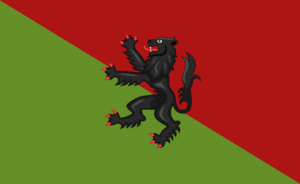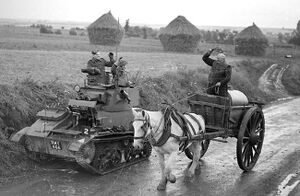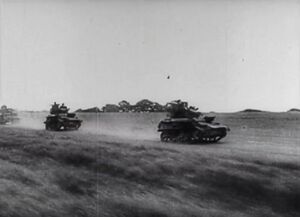Arcerion Tank Regiment: Difference between revisions
mNo edit summary |
|||
| Line 22: | Line 22: | ||
| commander3_label = | | commander3_label = | ||
}} | }} | ||
The '''Arcerion Tank Regiment''' is the senior armoured regiment of the [[Arcer Army|Arcer Army's]] [[Arcerion Armoured Corps|Armoured Corps]]. It consists of different squadrons and sub-units, both regular and reserve, each of which forms their own individual regiments within their individual brigades. The Regiment has the distinction as the oldest organized modern armoured regiment in mainland [[Crona]], and shares its multitude of battle honours with other infantry and cavalry regiments from Arcerion. It forms the main armoured core of [[Structure of the Arcer Army#1 Rifle Brigade|1 Rifle Brigade]], as well as [[Structure of the Arcer Army#4 Mechanized Brigade|4 Mechanized]] and [[Structure of the Arcer Army#5 Mechanized Brigade|5 Mechanized]] Brigades. The Regiment's main purpose is the conduct of maneuver warfare via its main battle tanks and armoured fighting vehicles, and is the only dedicated armoured regiment in the Army that is primarily focused on main battle tanks. | The '''Arcerion Tank Regiment''' is the senior armoured regiment of the [[Arcer Army|Arcer Army's]] [[Arcerion Armoured Corps|Armoured Corps]]. It consists of different squadrons and sub-units, both regular and reserve, each of which forms their own individual regiments within their individual brigades. The Regiment has the distinction as the oldest organized modern armoured regiment in mainland [[Crona]], and shares its multitude of battle honours with other infantry and cavalry regiments from [[Arcerion]]. It forms the main armoured core of [[Structure of the Arcer Army#1 Rifle Brigade|1 Rifle Brigade]], as well as [[Structure of the Arcer Army#4 Mechanized Brigade|4 Mechanized]] and [[Structure of the Arcer Army#5 Mechanized Brigade|5 Mechanized]] Brigades. The Regiment's main purpose is the conduct of maneuver warfare via its main battle tanks and armoured fighting vehicles, and is the only dedicated armoured regiment in the Army that is primarily focused on main battle tanks. | ||
The Regimental motto of 'Forgo the Odds" is drawn from its participation at the [[Battle of Westchester]], where the entirety of the Regiment fought for the first time, despite being outnumbered by Kelekonese forces, and then Commanding Officer Lieutenant-Colonel Anthony MacGuire commented the phrase when asked if he was concerned about the numerically superior forces. | The Regimental motto of 'Forgo the Odds" is drawn from its participation at the [[Battle of Westchester]], where the entirety of the Regiment fought for the first time, despite being outnumbered by Kelekonese forces, and then Commanding Officer Lieutenant-Colonel Anthony MacGuire commented the phrase when asked if he was concerned about the numerically superior forces. | ||
| Line 44: | Line 44: | ||
By the end of 1930, Taernsby saw the Regiment reunited, as the Squadrons had been partitioned off the support different elements of the Arcer Army Brigades fighting in Ardmore. The reunification of the Regiment was to prepare for a counterattack during the evacuation of Taernsby, as Arco generals believed the South Island was no longer tenable to hold due to the crumbling Ardmori Army and increases in communist forces maneuvers. The town of Taernsby, located two hours East of Balnaessie, was the sight of significant fighting. A and B Squadrons, supported by C Squadron and elements of the Arcerion Loyal Horse, conducted a significant counter-attack, destroying one communist brigade and forcing another to retreat, allowing Loyalist forces to evacuate their troops and much of the sympathetic civilian populace. | By the end of 1930, Taernsby saw the Regiment reunited, as the Squadrons had been partitioned off the support different elements of the Arcer Army Brigades fighting in Ardmore. The reunification of the Regiment was to prepare for a counterattack during the evacuation of Taernsby, as Arco generals believed the South Island was no longer tenable to hold due to the crumbling Ardmori Army and increases in communist forces maneuvers. The town of Taernsby, located two hours East of Balnaessie, was the sight of significant fighting. A and B Squadrons, supported by C Squadron and elements of the Arcerion Loyal Horse, conducted a significant counter-attack, destroying one communist brigade and forcing another to retreat, allowing Loyalist forces to evacuate their troops and much of the sympathetic civilian populace. | ||
The Regiment continued to fight during the Battle of the Southern marshes, where it hastily went to defend the retreating Arcer and Ardmori forces attempting to reach the port of Kilikken as they withdrew from the numerically superior communist forces. This would be the Regiment's last action of the war, and it was withdrawn with the [[Kiravia|Kiravian]]-negotiated armistice in 1931. The war gave the Regiment much needed experience, as well as hard-fought lessons in modern armoured warfare. An importance on the use of radios, coordination with other elements (especially engineers), and the requirement for maintenance and repair units to be close by to assist with the repair and recovery of non-combat losses would all be applied thoroughly in the Second Great War. | The Regiment continued to fight during the Battle of the Southern marshes, where it hastily went to defend the retreating Arcer and Ardmori forces attempting to reach the port of Kilikken as they withdrew from the numerically superior communist forces. This would be the Regiment's last action of the war, and it was withdrawn with the [[Kiravia|Kiravian]]-negotiated armistice in 1931. The war gave the Regiment much needed experience, as well as hard-fought lessons in modern armoured warfare. An importance on the use of radios, coordination with other elements (especially engineers), and the requirement for maintenance and repair units to be close by to assist with the repair and recovery of non-combat losses would all be applied thoroughly in the Second Great War. | ||
=== [[Second Great War]] === | === [[Second Great War]] === | ||
Lightfoot | Lightfoot | ||
Revision as of 11:51, 6 May 2023
| Arcerion Tank Regiment | |
|---|---|
| ATR | |
 | |
| Active | 1929-present |
| Country | Arcerion |
| Type | |
| Role | Armour |
| Size | ~2,500 (2020s) |
| Garrison/HQ | Corbray Barracks, Arcerion Armed Forces Base Presdale |
| Motto(s) | "Forgo the odds" |
| Anniversaries | 31 January 1929 (founding) 12 October 1991 Battle of Westchester |
| Engagements | Arcer Bush Wars, Ardmori Civil War, Second Great War, Telekonese Conflict, Final War of the Deluge |
| Commanders | |
| Commanding Officer | LCol Rowan O'Sullivan |
| Regimental Sergeant Major | WO1 Keelan Rogers |
The Arcerion Tank Regiment is the senior armoured regiment of the Arcer Army's Armoured Corps. It consists of different squadrons and sub-units, both regular and reserve, each of which forms their own individual regiments within their individual brigades. The Regiment has the distinction as the oldest organized modern armoured regiment in mainland Crona, and shares its multitude of battle honours with other infantry and cavalry regiments from Arcerion. It forms the main armoured core of 1 Rifle Brigade, as well as 4 Mechanized and 5 Mechanized Brigades. The Regiment's main purpose is the conduct of maneuver warfare via its main battle tanks and armoured fighting vehicles, and is the only dedicated armoured regiment in the Army that is primarily focused on main battle tanks.
The Regimental motto of 'Forgo the Odds" is drawn from its participation at the Battle of Westchester, where the entirety of the Regiment fought for the first time, despite being outnumbered by Kelekonese forces, and then Commanding Officer Lieutenant-Colonel Anthony MacGuire commented the phrase when asked if he was concerned about the numerically superior forces.
The Regiment is currently undergoing a significant change and re-evaluation as part of the 2022 Confederate Memo on Defence.
History
After the use of early armoured landships by Levantine armies during the First Great War, Arcer defense attache Colonel Patrick MacGowan sent correspondence from his post as the Arcer Defense Attache to Urcea on the need for these new types of fighting vehicles. This coincided with the increased use of motorisation by modern Levantine Armies. The letter noted that armoured vehicles should be accompanied by truck-bone infantry, or in some cases half-tracks, to create more mobile and dynamic forces to fight and defend large flat terrain such as the Arcer Heartland. The issue was not immediately seized upon, as peaceful relations after the Washakaran Campaign between Arcerion and Paulastra, as well as the lack of a significant Indigenous nation to oppose Arcer rule meant that the regular deployment of Army forces was often in a police-action fashion. However the Arcer General Staff realized the need for modern techniques and capabilities and sponsored the study and research of these vehicles. The study's conclusion spawned the creation of the Arcerion Armoured Corps on the 1st of January, 1929 with the Regiment's founding authorized by Parliament a month later on the 31st. A number of historical cavalry regiments were converted into armoured reconnaissance and lighter armoured formations, whereas the ATR was specifically dedicated to the use of tanks for engaging other armoured forces and support to the infantry.

Founding
The Regiment's founding was assisted by the need for additional assets to fight in the rapidly growing Ardmori Civil War, where the armoured car squadrons of the Royal Arcerion Dragoons and Arcerion Loyal Horse were facing newer anti-tank weapons and the hardened bunkers and structures of the Ardmori communist forces required additional direct fire support, which the Dragoons and Loyal Horse were unable to provide as their armorued cars were only equipped with machineguns.
With Parliamentary approval, the Armoured Corps oversaw the creation of four squadrons of armoured forces, those being a Headquarters Squadron (HQ), as well as three lettered squadrons (A, B, and C) with the first two containing newly developed tanks produced by the Arcer automobile industry and the third Squadron organized as a combat support squadron with halftracks for reconnaissance as well as truck-towed anti-tank guns. These four squadrons were organized into 1 Arcerion Tank Regiment (1ATR). These forces were trained hastily at Presdale for the summer of 1929, staying in newly constructed lines and barracks and practicing gunnery, communication, maintenance, and coordination with infantry units.
Initial findings from these exercises was that the 2-pdr (40mm) were sufficient to support the infantry in assaults, and using high-explosive ammunition were able to achieve better fire superiority then the light-m and medium-machinegun equipped Dragoons and Loyal Horse. These, combined with the direct-fire guns in C Squadron boarded ships in the Fall of 1929 to be quickly sent overseas for service in Ardmore, where the latter stages of 1929 had seen a slow degradation of the Royal Army and the Loyalist faction's ability to withstand.
Ardmori Civil War

All four squadrons arrived at port shortly after Christmas Day, 1929. They spent the first two weeks of the New Year preparing for movement, with fuel trucks and maintenance being conducted near the port facilities at Balnaessie. With preparations complete, the Regiment conducted its first road march to the South, and spent the next few months assisting members of the Royal Moorden Regiment who were conducting a slow fighting withdrawal from Wolford. The tanks saw their first action against multiple communist and socialist brigades, and lessons learned regarding the cooperation and coordination with combat engineers for the creation of defensive fighting positions helped the Regiment greatly. B Squadron conducted a successful counter-attack in June of 1930, preventing a battalion from Northlea Rifle Regiment from being cut off after it had begun to run low on ammunition. During the course of the counter attack, the Regiment suffered its first combat losses, with the destruction of three tanks from the Squadron, and one lost due to maintenance issues with the engine, according to the Regimental archives.
By the end of 1930, Taernsby saw the Regiment reunited, as the Squadrons had been partitioned off the support different elements of the Arcer Army Brigades fighting in Ardmore. The reunification of the Regiment was to prepare for a counterattack during the evacuation of Taernsby, as Arco generals believed the South Island was no longer tenable to hold due to the crumbling Ardmori Army and increases in communist forces maneuvers. The town of Taernsby, located two hours East of Balnaessie, was the sight of significant fighting. A and B Squadrons, supported by C Squadron and elements of the Arcerion Loyal Horse, conducted a significant counter-attack, destroying one communist brigade and forcing another to retreat, allowing Loyalist forces to evacuate their troops and much of the sympathetic civilian populace.
The Regiment continued to fight during the Battle of the Southern marshes, where it hastily went to defend the retreating Arcer and Ardmori forces attempting to reach the port of Kilikken as they withdrew from the numerically superior communist forces. This would be the Regiment's last action of the war, and it was withdrawn with the Kiravian-negotiated armistice in 1931. The war gave the Regiment much needed experience, as well as hard-fought lessons in modern armoured warfare. An importance on the use of radios, coordination with other elements (especially engineers), and the requirement for maintenance and repair units to be close by to assist with the repair and recovery of non-combat losses would all be applied thoroughly in the Second Great War.
Second Great War
Lightfoot
Interwar Period
Development, modern tanks, C sqn to Istrenya
Fourth Bush War
COIN ops and fire support (limited role)
Telekonese Conflict
defense of dunborough
battle of westchester
Final War of the Deluge
Operation Pullman